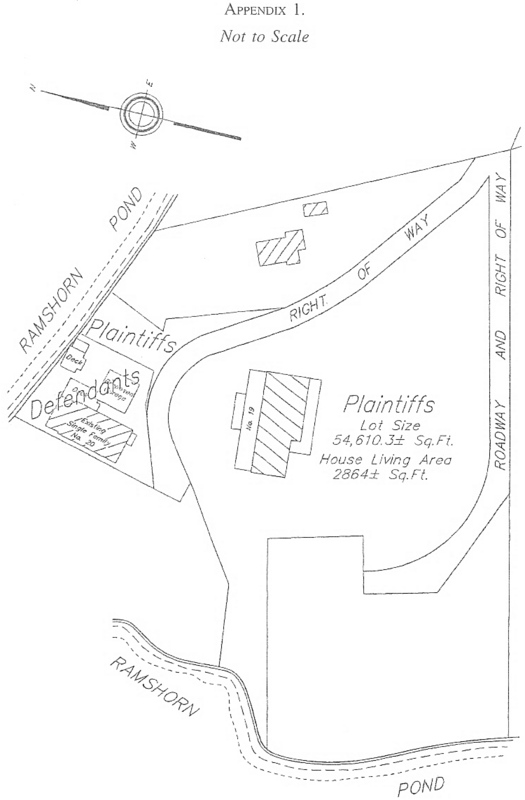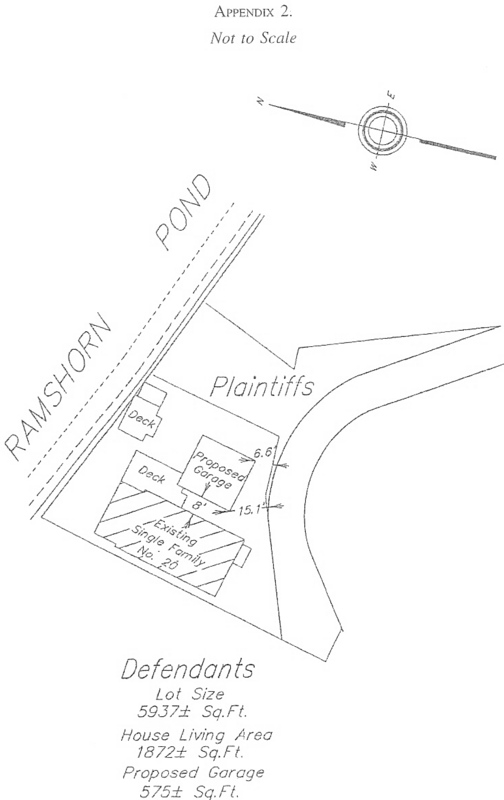MILLS, J. A Land Court judge, on cross motions for summary judgment, determined that the plaintiffs Robert and Linda Marhefka lacked standing to contest, on a complaint pursuant to G. L. c. 40A, § 17, the grant of a variance by the zoning board of appeals (board) of the town of Sutton (town) to Roseanne
Page 516
LaBarre and John Scott (defendants). [Note 3] The judge ruled that the injury claimed by the plaintiffs, some loss of view of an adjacent pond, was an insufficient basis for standing because views are not a protected interest under the local zoning by-law. [Note 4] We conclude that the plaintiffs did assert a competent basis for standing, and we reverse.
1. Background. On appellate review of a judge's decision on cross motions for summary judgment, we view the record in the light most favorable to the party against whom the judge allowed summary judgment, here the plaintiffs. See Albahari v. Zoning Bd. of Appeals of Brewster, 76 Mass. App. Ct. 245, 248 & n.4 (2010).
The plaintiffs and defendants own adjacent homes in the town. Both properties have frontage on Ramshorn Pond, and the parties share a common, unpaved right of way to access their homes. The defendants' access on the right of way is over the plaintiffs' property. The defendants' property consists of a 5,937 square foot lot with a single-family residence. They proposed to build a two-car garage, with attic space above, on a building footprint twenty-four feet by twenty-four feet.
The properties are within an R-1 zoning district which requires a minimum lot size of 80,000 square feet. Other dimensional criteria include 250 feet of minimum frontage, a minimum of fifty feet of front and rear setback, and twenty feet minimum of side setback. For accessory structures, such as the proposed garage, side and rear setbacks require only a minimum of ten feet. As to density, the by-law permits a maximum lot coverage of ten percent.
The defendants' existing lot and use violate the dimensional and density provisions of the by-law. [Note 5] The lot is 5,937 square feet, less than ten percent of the minimum 80,000 square feet.
Page 517
The existing lot frontage is eighty-seven feet, substantially less than the minimum 250 feet. The distance from the existing building to the easterly side lot line is approximately four feet, where twenty feet is the minimum, and the distance to the rear lot line is ten feet, where fifty feet is required. The lot coverage of the existing use is eighteen percent where the maximum allowed is ten percent. The proposed garage would be approximately 6.6 feet from the front lot line, where fifty feet are required. The board granted the defendants a variance from these dimensional and density provisions.
The defendants' existing use, while historically consistent with the cottage-campsite character of several surrounding properties, is nonconforming as to density and dimensions under the current by-law. The addition of the garage will increase the existing density and dimensional nonconformity, and the proposed garage will partially obscure the plaintiffs' view of the pond from their home.
The plaintiffs appealed the grant of the variance in the Land Court pursuant to G. L. c. 40A, § 17. On cross motions for summary judgment, the judge allowed the defendants' motion and denied that of the plaintiffs, reasoning that the plaintiffs had not alleged violation of an interest protected by the by-law. This appeal followed.
2. Standard of review. We review the Land Court judge's summary judgment decision de novo. Albahari v. Zoning Bd. of Appeals of Brewster, supra at 248. Because the judge does not engage in fact finding in ruling on cross motions for summary judgment, we owe no deference to his assessment of the record. [Note 6] See ibid. Contrast Marashlian v. Zoning Bd. of Appeals of Newburyport, 421 Mass. 719, 720, 722 (1996) (appellate court
Page 518
will not set aside judge's findings, after contested evidentiary hearing, about standing unless "clearly erroneous").
A defendant seeking summary judgment may carry its burden by showing that the plaintiff has no reasonable expectation of proving an essential element of his claim. See Kourouvacilis v. General Motors Corp., 410 Mass. 706, 716 (1991). After a defendant meets this burden, the plaintiff must show, with evidence, the existence of a material dispute as to the essential element. See Godbout v. Cousens, 396 Mass. 254, 261 (1985). If the plaintiff can do so, summary judgment is not proper.
3. Standing. The judge determined that the plaintiffs' claims of loss of view and resulting diminution of property value are not protected interests under the by-law. As a result, he concluded that the plaintiffs lacked standing to proceed under G. L. c. 40A, § 17. We disagree with the judge's analysis.
Under the Zoning Act, only a "person aggrieved" may appeal a decision of a zoning board. G. L. c. 40A, § 17. This requirement is jurisdictional "in the sense that it is a criterion that must be met in order for the court to exercise jurisdiction, when the court otherwise is competent to decide the case." Southwick v. Planning Bd. of Plymouth, 72 Mass. App. Ct. 266, 268 (2008).
In order to qualify as a "person aggrieved," one must assert "a plausible claim of a definite violation of a private right, property interest, or legal interest." Harvard Square Defense Fund, Inc. v. Planning Bd. of Cambridge, 27 Mass. App. Ct. 491, 493 (1989). Abutters enjoy the presumption of standing, G. L. c. 40A, § 11, but adverse parties may challenge the presumption, Marashlian, 421 Mass. at 721. When so challenged, the judge determines standing based on "all the evidence with no benefit to the plaintiffs from the presumption." Ibid. (quotation omitted). This review does not require that the party seeking judicial review prevail on the merits to secure standing; the party need only present "credible evidence to substantiate his allegations." Ibid.
"The right or interest asserted must be one that the [by-law] under which a plaintiff claims aggrievement intends to protect." Standerwick v. Zoning Bd. of Appeals of Andover, 447 Mass. 20, 27-28 (2006). Such a protected interest can arise from the
Page 519
by-law's express language. See, e.g., Monks v. Zoning Bd. of Appeals of Plymouth, 37 Mass. App. Ct. 685, 688 (1994) (by-law expressly protected "visual character or quality of the neighborhood"). Such a protected interest can also arise implicitly from the intent of the by-law's provisions. See, e.g., Sheppard v. Zoning Bd. of Appeal of Boston, 74 Mass. App. Ct. 8, 12 (2009) ("The requirements regarding lot size, lot width, and side yard are intended to further [the general purposes of the by-law]").
Specifically, where a by-law regulates density and dimensions, "[w]e have recognized an abutter's legal interest in 'preventing further construction in a district in which the existing development is already more dense than the applicable zoning regulations allow.' " (citation omitted). Dwyer v. Gallo, 73 Mass. App. Ct. 292, 296 (2008). See Tsagronis v. Board of Appeals of Wareham, 33 Mass. App. Ct. 55, 59 (1992), S.C., 415 Mass. 329 (1993) (further construction interfering with water view in district with existing over-dense development conferred standing); Sheppard, 74 Mass. App. Ct. at 12.
We conclude that the plaintiffs sufficiently alleged invasion of interests protected by the by-law. See Dwyer, 73 Mass. App. Ct. at 296; Sheppard, 74 Mass. App. Ct. at 12. We further conclude that they have presented a genuine issue of material fact as to whether credible evidence supports their assertion of individual injury sufficient to qualify them as "person[s] aggrieved." Summary judgment was not proper.
The defendants presented appraisal evidence challenging the plaintiffs' presumption of standing, thus requiring the plaintiffs to show particularized injury with credible evidence sufficient to qualify them as "person[s] aggrieved." Marashlian, 421 Mass. at 721.
The board granted the defendants a variance to construct a garage which increased the preexisting density and dimensional nonconformity. The density and dimensional requirements of the by-law confer standing on the plaintiffs to challenge the variance based on the aggravation of the preexisting nonconformity of adjoining lots. The by-law extensively regulates the
Page 520
dimensions of lots and density of use. [Note 7] The front, rear, and side yard criteria are extensive. The by-law defines "[o]pen [s]pace" as "[t]he portion of the lot area not covered by any structure and not used for drives, parking, or storage. . . ." The by-law also describes "[y]ard" as:
"An undeveloped, naturally vegetated and/or landscaped strip required per the Table of Dimensional Regulations along the full length of a lot line on the same lot as a permitted structure and/or use, and lying between said structure and/or use and the nearest lot line, unobstructed from the ground upward and unoccupied except by specific structures and/or uses allowed by the provisions of this Bylaw. Said yard is intended to provide aesthetic value as well as serve as a spatial and visual buffer between lots."
The by-law also addresses reduction of open space on any nonconforming lot. It is undisputed that the proposed garage would violate the by-law's density and dimensional provisions. Accordingly, the plaintiffs have alleged an injury of an interest protected by the by-law. [Note 8]
The view injury the plaintiffs have alleged relates to protected density and dimensional interests. The by-law identifies open space and describes "yard" in such a manner as to make protection of view an implicit interest protected by the density and dimensional provisions of the by-law. As a matter of common sense, the yard and setback requirements have a purpose to preserve open space, implying the ability to see through the open space. As a result, the plaintiffs' claims of diminished water view allege a violation of an interest protected by the by-law.
Of course, the plaintiffs' claim of an impairment of water view, without more, does not confer standing. See Sheehan v. Zoning Bd. of Appeals of Plymouth, 65 Mass. App. Ct. 52, 55
Page 521
(2005) ("we do not read the Tsagronis case to confer standing on a property owner who claims development will obstruct a water view"). But where, as here, a neighbor asserts diminished water view as a result of further violation of by-law density and dimensional provisions, including those calling for a "visual buffer" between lots, on an already nonconforming lot, then such an intrusion can confer standing. [Note 9]
The defendants presented evidence tending to show that the proposed construction would constitute, at worst, a de minimis invasion of the plaintiffs' water view. The plaintiffs have submitted contradictory evidence claiming substantial loss of and damage to their protected interests. The disputed degree of the injury renders this case inappropriate for summary judgment. Because the degree of the quantity and quality of the view impairment due to the increased density was not decided by the Land Court judge, we decline to determine whether the plaintiffs have presented sufficient credible evidence of a particularized injury to warrant standing. [Note 10] The Land Court judge must determine, in the first instance, whether the plaintiffs have met their burden to submit credible evidence of the alleged injury. See Butler v. Waltham, 63 Mass. App. Ct. 435, 440-442 (2005) (discussing quantum of proof necessary to constitute "credible evidence" of special and different injury).
4. Conclusion. The judgment is reversed. The matter is remanded to the Land Court for further proceedings consistent with this opinion.
So ordered.
Page 522

Page 523

 ROBERT E. MARHEFKA & another [Note 1] vs. ZONING BOARD OF APPEALS OF SUTTON & others. [Note 2]
ROBERT E. MARHEFKA & another [Note 1] vs. ZONING BOARD OF APPEALS OF SUTTON & others. [Note 2]

